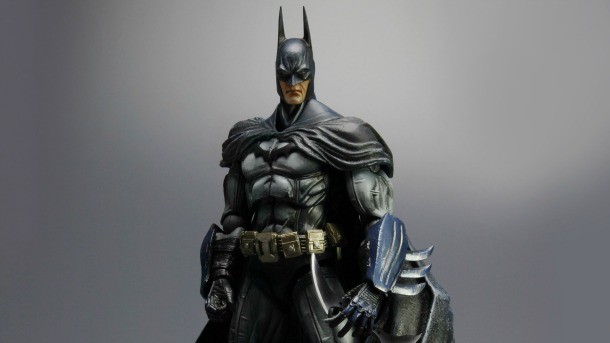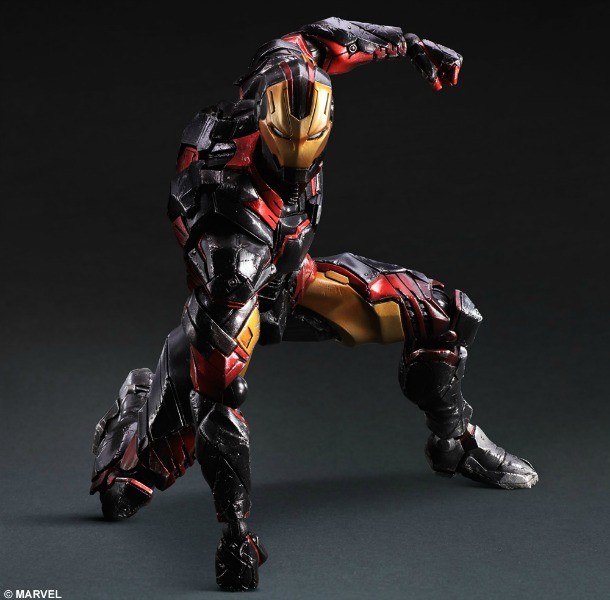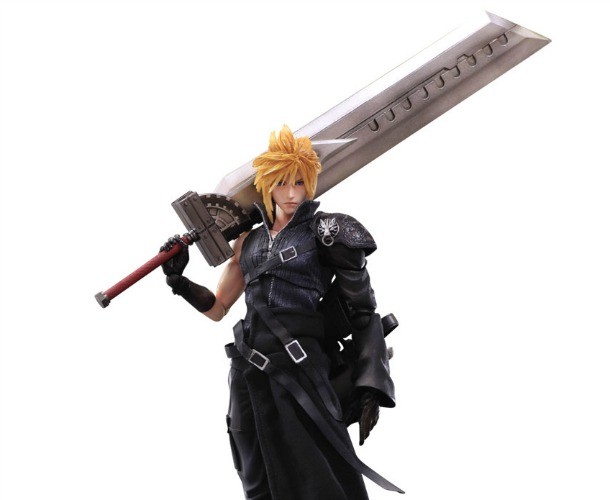Our extra-large special edition is here. Subscribe today and receive the 25% longer issue at no extra cost!
The Artistry Of Play Arts

If you’re into the collectibles scene, then you’re probably already familiar with the excellent line of Play Arts figures produced by Square Enix. Originally, the Play Arts line acted as an avenue for the game publisher to deliver high quality figures to fans of its games. As the team's expertise grew, other external brands began to join the collection. Today, Play Arts figures are available for a broad variety of game, comic, and movie characters, and are some of the most sought after and prized display pieces for toy enthusiasts.
We asked Square Enix’s senior director of merchandise, Kanji Romeo Tashiro, to tell us more about the success of the Play Arts line.
How long has the Play Arts line of toys been around? How and why did the line of figures get started?
The first action figures we developed in-house were Final Fantasy X-2 Play Arts Yuna, Rikku, and Paine in 2003. This marked the beginning of our Play Arts series.
Until then all of the Final Fantasy merchandise had been licensed to other manufacturers, which had some drawbacks. Regardless of the review process that went into developing the product, we were ultimately not in control of the final quality level. Additionally, we found it increasingly difficult to ensure that the products would release according to our desired schedule.
In creating our own Square Enix character products, we set out with very high quality standards. And because we can consult directly with the creators who breathed life to these characters we are able to ensure that their vision is realized in the final products. Ultimately, we believed that regardless of the challenges we faced (especially since we were inexperienced in the toy industry), producing these products in-house was in the best interest of our fans, who love our characters. Also, it was the only way that we could ensure that our characters were presented in the best possible manner.
It was not an easy road for us. However, with each new character added to our Play Arts line, we continuously improved the quality of our merchandise—from modeling to coloring to articulation and pretty much every aspect of an action figure. The validation of our efforts can be seen in the responses from our fans, which has only gotten better and better over time.
Play Arts figures are a combination of internal Square Enix properties, like Final Fantasy, and external properties, like Batman and Halo. When and how did the series expand to include external properties?
As our products were evolving and improving, as mentioned earlier, the Play Arts series entered into a new chapter of product development in 2009. This is when we shifted gears, creating the Play Arts -KAI- series, which is larger in scale than its predecessor, and has finer detailing and coloring. The first line of figures released in this new series was from Resident Evil 5. Thinking about it now, it’s very moving since it marked our first release of a product licensed from an external company, Capcom in this case.
There are two main reasons for deciding to produce figures for characters from other companies, and not just our own.
Frankly speaking, the first was the limited number of products we could create just using characters from Square Enix titles. After all, new Final Fantasy games were not released every year. Additionally, we did not want to continue producing redundant merchandise from the same titles in a short amount of time.
The second reason was that, as we continued to improve our Play Arts series, we had gained confidence as a manufacturer. We wanted to take on new challenges as a collectible toys manufacturer rather than just a department in a video game company.
We already had a long-running relationship with Capcom through Square Enix’s publishing department which published comic books based on their games. After numerous discussions with Capcom, they agreed to license their IP to us so we could develop action figures.
In that sense, the shift to Play Arts -KAI- was also a big turning point.
The Play Arts -KAI- series has been growing ever since, partnering with various video game companies including Capcom with their Resident Evil, Devil May Cry, and Street Fighter 4 series, Konami with their Metal Gear Solid series, and Microsoft with their Halo series, just to name a few.
And in 2012, we were able to license Batman: Arkham Asylum from Warner Bros. Interactive to release a Play Arts -KAI- figure line. Though it was for a Batman video game, it was still a huge leap for us to be able to produce a figure of an American comic book hero, since comics are synonymous with action figures.
Next Page: The wild imaginings of the Variants line

When working with a licensed franchise, Play Arts has some figures that are recreations of the established vision of a character, and others called Variants that involve more reinterpretation. How did that distinction begin?
We have been creating Play Arts -KAI- figures for the video game and film versions of Batman, Superman and other characters through our partnership with Warner Bros. and they were received favorably from fans. When we proposed a new line of figures with our unique perspective on the look of the heroes, we were delighted by Warner Bros’ gracious approval.
The name Variant Play Arts -KAI- stems from the American comic book tradition of having “variant” covers, where an alternate cover design is inspired by a different source from the original or is simply drawn by a different artist than one who regularly works on the given comic book.
The concept designs for the Variant Play Arts -KAI- series are mainly created by our in house designer, Hitoshi Kondo, and have been highly regarded by fans and in the market. We are planning to release at least two new series of Variant Play Arts -KAI- lines this summer: one was designed by Tetsuya Nomura, who is renowned for his character designs for the FINAL FANTASY series; the other was designed by Hitoshi Kondo based on a concept by one of our staff in the U.S. office. Other Variant series – for Marvel Comics, Predator and Hatsune Miku – will also be released in the coming months.
We hope our fans are excited for further series developments and improvements to come!
How has the process of creating these figures changed over the years? From an outside perspective, it seems like more recent figures exhibit greater detail and color nuance than older figures. Does that reflect a change in how they’re being created?
Along with the expansion of the Play Arts -KAI- series line-up, we are constantly looking for ways to improve the quality of our products. This includes innovations in the research and development of joint structures to hold a wider range of action poses; utilization of new flexible materials to prevent hindering joint movement; the incorporation of multiple layers of paint to reproduce a more realistic appearance of the materials, and more.
However, there is one thing that that hasn’t changed: the base sculpture creation process, which is the starting point for all our figures.
Many people may think that a figure prototype sculpture for a video game character can be created quickly as long as we have the 3D model data. While we may refer to the 3D model data to get a better idea of the body balance and proportions of a character, it is important for the sculptor to sculpt out the base model. For example, even though the 3D game model is correct, the action figure created directly from that model may not look very cool or appealing. This is because the 3D model is created with how it will be viewed on a monitor in-game in mind, not as a live 3D object. With our figures, experienced figure sculptors make fine adjustments to the models so we can reproduce an “aura” that the character exerts in-game, as if they stepped out of the monitor into the real world. I believe that in the golden age of digital data, this kind of craftsmanship is more important now than ever.
Play Arts figures seem to walk a line between traditional action figures and a more artistic experience, almost like pose-able statues. Where do you draw the line between having the figures be objects that are fun to play with, or objects for display on a shelf?
I agree that our Play Arts -KAI- series is slightly different than the type of action figures intended for small children. Our intent is to enable our customers, who probably prefer a more careful and deliberate style of play, to enjoy the figures by recreating memorable and evocative character moments in the posing and display of them in a specific way. This is why our recent releases come with a display stand that will keep the figures in a particular pose.
Durability and safety are probably of the highest priority for figures meant for children. This is so it will be hard for them to break apart, even if banged against objects or dropped on the floor. Our figures are not fit for that play style, to say the least. Instead, we have focused on a wide range of joint movements and the details of the model to generate the quality needed for, as you said, a “pose-able statue.” We hope that our figures are displayed by our fans with love and pride.
Next Page: What determines which figures come to the United States?

Many Play Arts figures come to the United States, but others (like the recently revealed Star Wars figures) are exclusive to Japan or other territories. What goes into the decision-making process about where figures are made available for purchase?
This is mainly a business decision made by our licensors. Especially for global IPs, licensors often already have an existing partnership with other licensees. In some cases, our distribution is limited to certain territories to respect those partnerships and avoid cannibalization with other licensees. Since we receive requests from fans to release certain figures in territories where we do not have the right to sell the products, our hope is always to establish partnerships that allow us to release globally wherever possible.
What’s your personal favorite Play Arts figure that has been released? What do you like about it?
Naturally, I love all of them, but with that said, my favorite figure from our recent release is Cloud from the Final Fantasy VII Advent Children Play Arts -KAI- series.
Your readers may already know this, but Cloud Strife is a character beloved by fans for almost two decades. Because of that, we have produced many versions of Cloud, both with Play Arts and Play Arts -KAI-. However, I do feel attached to this one, as it is the first Advent Children Cloud figure to be released in the Play Arts -KAI- series. We were very particular about the details such as the different types of weapons that come with it for accessorizing and parts of its costume made out of cloth, so please look forward to it!
Do you expect to see the Play Arts line expand into any new franchises in the next year? Or are you sticking with existing partners? What goes into the process of deciding on which character to create from which franchise?
We are constantly listening to our fans and are incorporating feedback from our licensors and distribution channels to decide on the line-up.
We believe we have evolved quite a bit in the past five to ten years, so we would like to continue evolving. We will continue to release products from the popular IPs in our existing line-up and we should be able to announce new IPs this year. We are so grateful to, and sincerely wish for, the continued support of our fans, who make it all possible!

Get the Game Informer Print Edition!
Explore your favorite games in premium print format, delivered to your door.
- 10 issues per year
- Only $4.80 per issue
- Full digital magazine archive access
- Since 1991









